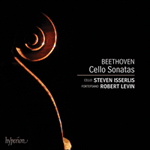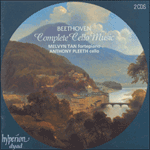
Welcome to Hyperion Records, a British classical label devoted to presenting high-quality recordings of music of all styles and from all periods from the twelfth century to the twenty-first.
Hyperion offers both CDs, and downloads in a number of formats. The site is also available in several languages.
Please use the dropdown buttons to set your preferred options, or use the checkbox to accept the defaults.

Beethoven had been told that his new friend could execute violoncello music upon his huge instrument, and one morning, when Dragonetti called at his room, he expressed his desire to hear a sonata. The contrabass was sent for, and the Sonata, No 2 of Op 5, was selected. Beethoven played his part, with his eyes immovably fixed upon his companion, and, in the finale, where the arpeggios occur, was so delighted and excited that at the close he sprang up and threw his arms around both player and instrument.
Like the First Sonata the G minor work has a slow introduction, which here is even more expansive, amounting to an expressive and often dramatic fantasia. The first Allegro is an example of Beethoven’s predilection for including a wide range of diverse material within one movement. The restrained opening theme is soon interrupted by a forte idea accompanied by pounding quaver triplets which are only brought to a halt with the lead-in to the more song-like second subject. The finale is again a rondo, this time in 2/4 time and in G major, with a variety of lively rhythmic patterning and much rapid figuration in demi-semiquavers, culminating in a hectic coda.
from notes by Matthew Rye © 1996
Beethoven avait appris que son nouvel ami pouvait exécuter de la musique pour violoncelle sur son énorme instrument. La contrebasse fut envoyée chercher, et la sonate no2 de l’opus 5 choisie. Beethoven joua sa partie, les yeux immuablement fixés sur son compagnon, jusqu’au finale et à l’apparition des arpèges. Là, il fut si enchanté et excité qu’il se leva d’un bond et lança ses bras autour du joueur et de l’instrument.Mo
extrait des notes rédigées par Matthew Rye © 1996
Français: Hypérion
Man hatte Beethoven erzählt, sein neuer Freund könne auf seinem großen Instrument Musik für das Violoncello spielen, und eines Morgens, als Dragonetti ihn in seinem Zimmer besuchte, äußerte er den Wunsch, eine Sonate zu hören. Es wurde nach dem Kontrabaß geschickt und die Sonate Nr. 2 des Op 5 gewählt. Während er seinen Teil der Musik spielte, wendete Beethoven nicht einen Moment die Augen von seinem musikalischen Kompagnon ab und war von den Arpeggios des Finales so begeistert und erregt, daß er zum Schluß aufsprang und seine Arme um sowohl Musiker als auch Instrument warf.
Wie die erste Sonate wird das Werk in g-Moll langsam eingeführt und hier sogar noch expansiver gestaltet, indem schließlich eine ausdrucksvolle und zuweilen dramatische Fantasie entwickelt wird. Das erste Allegro ist ein Beispiel von Beethovens Vorliebe, in einen Satz eine große Palette von unterschiedlichem Material einzubauen. Das verhaltene Thema der Eröffnung wird schon bald von einer mit forte bezeichneten Idee unterbrochen und von dröhnenden Achtelnoten-Triolen begleitet, denen erst beim Übergang zum zweiten, liederähnlichen Thema Einhalt geboten wird. Wiederum erscheint das Finale in Gestalt eines Rondos, dieses Mal im Zweivierteltakt und G-Dur, mit einer Vielfalt an lebhaft rhythmischen Strukturen und manch schneller Figuration in Zweiunddreißigstelnoten, bis es schließlich in einer hektischen Coda seinen Höhepunkt erreicht.
aus dem Begleittext von Matthew Rye © 1996
Deutsch: Ute Mansfeldt
 Beethoven: Cello Sonatas Beethoven: Cello SonatasIn this chamber recording, Steven Isserlis—together with his regular collaborator, fortepianist Robert Levin—presents a magisterial and long-awaited compendium of Beethoven’s complete works for cello and piano.» More |
 Beethoven: Complete Cello Music Beethoven: Complete Cello Music‘A distinguished contribution not only to the burgeoning corpus of period recordings, but to a continuing tradition of cello playing’ (Gramophone) ‘An attractive issue for anyone wanting period versions’ (The Penguin Guide to Compact Discs)» More |

